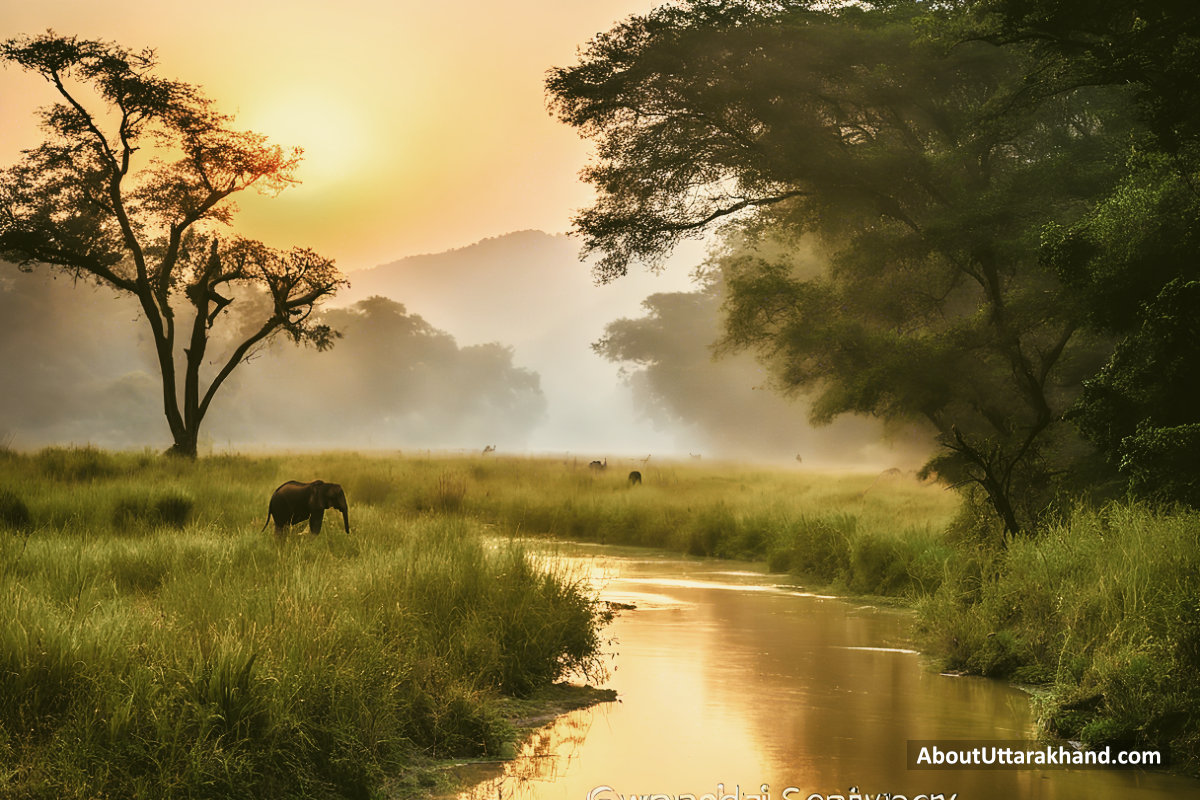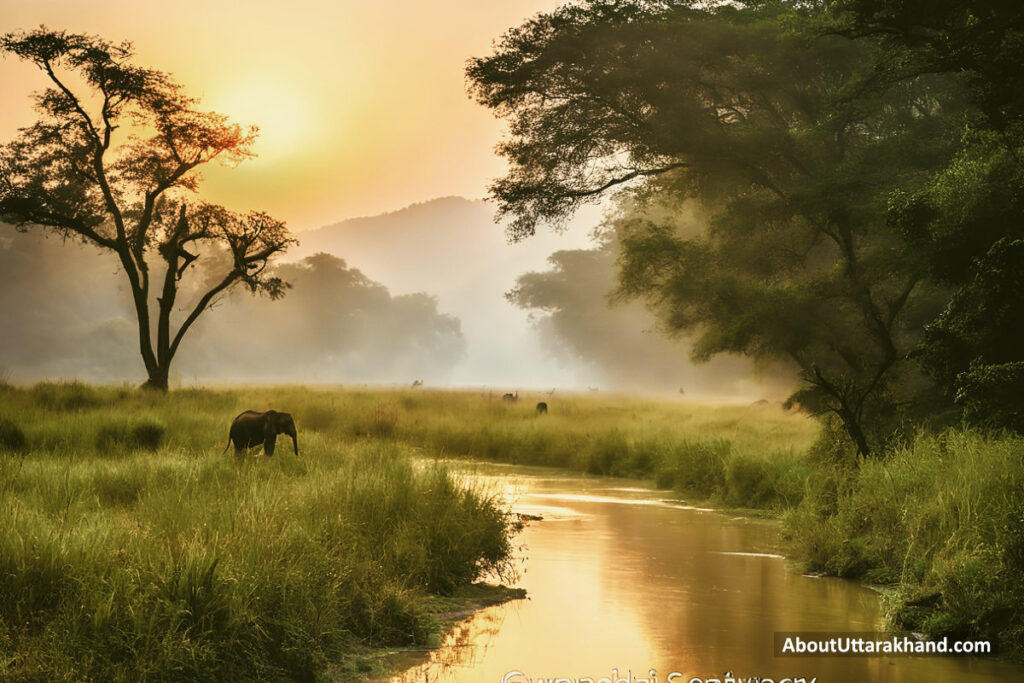Sonanadi wildlife sanctuary
The Sonanadi Wildlife Sanctuary invites animal lovers and nature lovers to come and enjoy the quiet beauty of Uttarakhand's serene surroundings. Hidden in the Nainital District, not far from Nainital, lies a refuge that begs to be discovered. Its varied wildlife and flora make this area, which covers around 301.18 square kilometres, a popular destination for ecotourists and those interested in biodiversity.
Table of Contents
Sonanadi wildlife sanctuaryDetails About Sonanadi wildlife sanctuary
History Of Sonanadi wildlife sanctuary
Best Time To Reach Sonanadi wildlife sanctuary
How To Reach Sonanadi wildlife sanctuary
Places To Visit Near Sonanadi wildlife sanctuary
To Conclude

Sonanadi Wildlife Sanctuary | Photo: AboutUttarakhand.com
Details About Sonanadi wildlife sanctuary
The Sonanadi Wildlife Sanctuary protects a wide range of habitats, making it a true haven for wildlife. Many different kinds of animals find a home in the sanctuary's varied ecosystems, which include grasslands, deep woods, and riverine habitats. Elephants, tigers, leopards, deer, and several bird species are among the many wildlife that visitors may see.
Trees such as Sal, Teak, and Sheesham predominate in the verdant scenery that adorns the sanctuary. In addition to providing shelter for the sanctuary's residents, the thick woodlands also make for a peaceful setting where guests can feel at one with nature.
Jungle safaris, birdwatching, and nature walks are just a few of the activities that guests can enjoy while they explore the sanctuary. Through the sanctuary's many well-kept paths, visitors may take in breathtaking vistas of the hills and valleys that surround the property and maybe even get a glimpse of some of the sanctuary's more elusive animals in their native environment.
History Of Sonanadi wildlife sanctuary
Since its founding in 1987, the Sonanadi Wildlife Sanctuary has been home to a diverse array of wildlife. It was established as a distinct sanctuary from the Corbett Tiger Reserve with the goal of safeguarding the biodiversity and natural heritage of the area. With a long history of dedicated service, the sanctuary has been an integral part of the fight to protect endangered species and the ecosystems in which they live.
Best Time To Reach Sonanadi wildlife sanctuary
Winter (October–February) and summer (March– June) are the ideal times to explore the Sonanadi Wildlife Sanctuary. The weather is nice and the sanctuary is full of animals during these seasons, so it's a great time to go nature watching and taking pictures. The clean air and bright skies also provide guests with stunning vistas of the landscape, elevating their overall experience.
How To Reach Sonanadi wildlife sanctuary
| By Road |
Road travel to Sonanadi Wildlife Sanctuary is convenient and scenic, letting you appreciate Uttarakhand's natural splendour. State highways and municipal roads connect the sanctuary to Nainital, 85 kilometres away. Nainital to Sonanadi takes about 3 hours, passing through forests, villages, and Kumaon hills. |
| By Train |
Sonanadi Wildlife Sanctuary is accessible by train and road. Ramnagar, 30 km from the sanctuary, is the nearest railway station. Delhi, Lucknow, and Moradabad are accessible from Ramnagar. Daily trains like the Ranikhet Express and Corbett Link Express make Delhi-Ramnagar travel easy. The 6- to 7-hour train ride from Delhi to Ramnagar across the Himalayan plains and foothills is comfortable and scenic. |
| By Air |
Many travellers choose plane travel to Sonanadi Wildlife Sanctuary for speed and convenience. Pantnagar Airport, 110 kilometres from the sanctuary, is closest. Pantnagar Airport is easily accessible from Delhi due to regular flights. The Delhi-Pantnagar flight takes an hour, making it a fast way to reach Uttarakhand. |
Places To Visit Near Sonanadi wildlife sanctuary
To Conclude
Finally, visitors are invited to immerse themselves in nature and discover the varied landscapes of Uttarakhand at the Sonanadi Wildlife Sanctuary, which provides a peaceful haven amidst the state's breathtaking natural splendour. Ecotourism and wildlife conservationists flock to the area for its breathtaking scenery and abundant plant and animal life. The sanctuary guarantees a memorable experience whether you're going on a jungle safari through its lush forests, watching rare animals from a distance, or just relaxing and taking it all in. Sites like the Sonanadi Wildlife Sanctuary encourage us to keep in mind the value of conservation and sustainable methods in protecting the world's rare and endangered species as we work to ensure that our natural history is around for generations to come.











Belle Fable, keeps your trend ahead!
Gaumukh Glacier
.The stunning Gaumukh Glacier, in the Uttarkashi region of Uttarakhand, India, is situated close to Gangotri and framed by the towering Garhwal Himalayas. Glaciers like this one attract tourists, hikers, and nature lovers from all over the globe because of the deep religious significance they have for Hindus as the headwaters of the holy Ganges River. The ascent to Gaumukh is an adventure in body and spirit, providing an opportunity to commune with the holy and the natural world.
Nandhaur Wildlife Sanctuary
The Nandhaur Wildlife Sanctuary is a haven for wildlife and stunning scenery, set in the tranquil hills of Uttarakhand. This sanctuary, in the Nainital District close to Haldwani, is a paradise for people who appreciate nature and animals. Its varied habitats, which include grasslands, ponds, and thick forests, have earned it recognition across its 269 square kilometers of territory.
Sonanadi Wildlife Sanctuary
The Sonanadi Wildlife Sanctuary invites animal lovers and nature lovers to come and enjoy the quiet beauty of Uttarakhand's serene surroundings. Hidden in the Nainital District, not far from Nainital, lies a refuge that begs to be discovered. Its varied wildlife and flora make this area, which covers around 301.18 square kilometers, a popular destination for ecotourists and those interested in biodiversity.
Binsar Wildlife Sanctuary
The Binsar Wildlife Sanctuary is a haven for wildlife and a monument to Uttarakhand's rich biodiversity, is situated in the picturesque Kumaon Himalayas. Nature lovers and wildlife aficionados will find this refuge, situated near Almora in the Almora District, to be a paradise. Covering about 47.04 square kilometers, it is famous for its verdant forests, varied fauna, and breathtaking views of the Himalayan mountains in the distance.
Tawaghat Wildlife Sanctuary
The Tawaghat Wildlife Sanctuary is a haven for adventurers and ecotourists, tucked away in the foothills of the towering Himalayas. This hidden gem of a sanctuary is located near Dharchula in Uttarakhand's Pithoragarh District. Despite its relatively tiny size (around 70 square km), this animal sanctuary is just as magical as any other.
Chilla Wildlife Sanctuary
.The Chilla Wildlife Sanctuary, located on the banks of the pure Ganges River, is a living monument to the beauty and variety of Uttarakhand's natural landscape. This sanctuary is a paradise for anyone who love nature and wildlife; it is located in the Pauri Garhwal District, close to Rishikesh. Covering over 249 square kilometers, it is a major wildlife sanctuary in the state that provides a peaceful haven amidst the majestic Himalayas.

